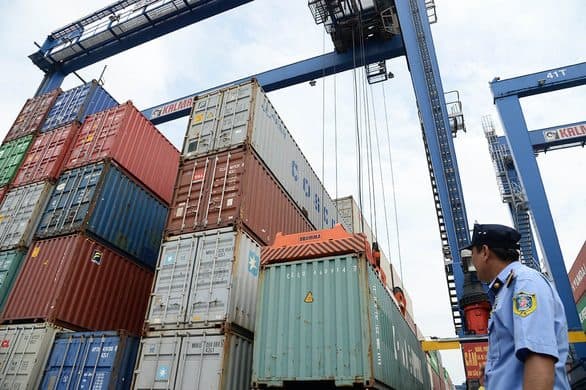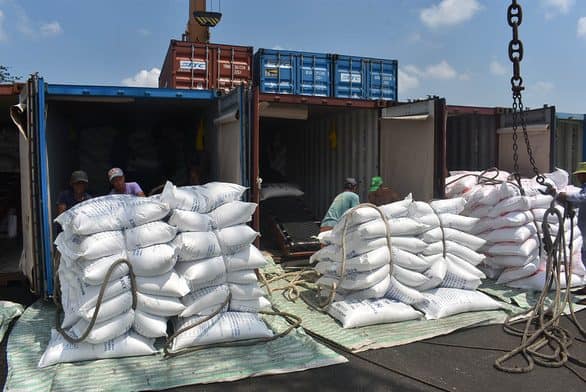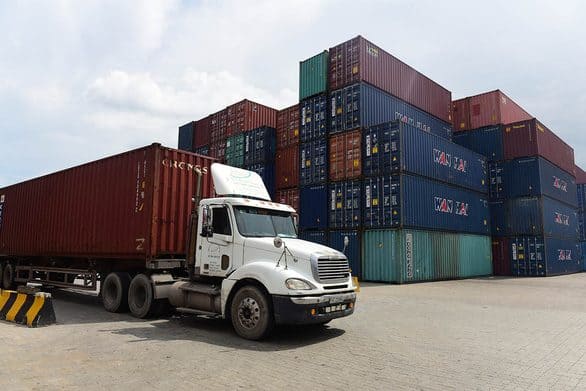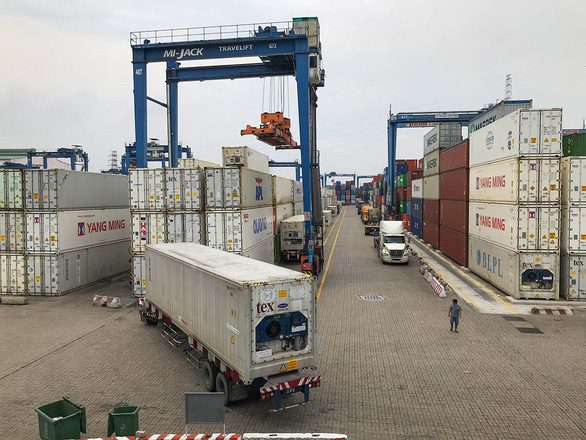TTO – Many enterprises exporting goods and agricultural products of Vietnam have to pay 3-4 times, even 10 times higher than normal, container charges to keep up with customers.
- One of the largest container ships in the world to dock in Vietnam for the first time
- Super container ship as long as 4 football fields at Cai Mep – Thi Vai
- Why is a container from Ho Chi Minh City to Vung Tau more expensive than going to Singapore?

The scarcity of containers raises the prices of goods, making it difficult for exporters – Photo: TRUNG TRUNG
Many businesses have to reduce 50-75% of export goods compared to normal due to lack of … containers.
The shortage of empty containers from shipping lines to export goods lasted for nearly 2 months but there is no sign of being resolved.
In Vietnam, the coffee and pepper crop has begun, businesses (DN) dare not buy from farmers because they cannot export. The price of many agricultural products is threatened with a deep decrease if this situation is not resolved.
The end of the year is the time for businesses to speed up the export of goods, serving the Tet peak. However, the export activities of Vietnamese enterprises are facing common difficulties, including the lack of empty containers for packing, the sudden increase in sea freight rates makes many businesses worried.
“Compared to China, Vietnamese goods exported are not significant, so shipping lines will focus on containers for this market first. Therefore, when Chinese exporters lack containers and are willing to pay the price. It will be more difficult for companies in Vietnam to export goods, but also for many other countries to have a container or to reduce rental rates in the near future.
Mr. Truong Dinh Hoe (General Secretary of Vietnam Association of Seafood Exporters and Producers)

To rent an empty container to export goods, businesses have to pay 3-4 times higher costs than before. In the photo: workers packing rice boxes for export at My Thoi port, Long Xuyen city, An Giang – Photo: BUU DUO
“Headache” looking to rent a container
Talking with Tuoi Tre, Mr. Vo Cong Thuc – deputy director of food production of Loc Troi Group – said in the month
12-2020, this company has planned to export 40 containers of rice to European markets, Canada, Ghana …
However, up to now, enterprises can only export 20 containers of rice, down 50% compared to the plan. The remaining 20 containers are taken to the storage by the unit to import with the export plan in January 2021, a total of about 100 containers.
“But with the current situation, we are not sure to achieve as planned, because we do not know whether the story of the shortage of empty containers will last until then. We have an advantage in the export contract. Import, contracting unit shipping fee paid by the customer, so the damage is less than some other businesses “- Mr. Thuc said.
He said that in the current scarcity of empty containers, exporters must make the most of their relationships with shipping companies to obtain export containers.
If any company contracts with a foreign country for the self-bear shipping fee, it is different, and the customer will bear it is another matter.
“Now transport companies have containers like” king “, because exporters have to fight with transportation companies to get containers to export goods.
If a few months ago we found any container that was bad or damaged, we would ask for it back, but now we have to ask someone to fix it to make the shipment. Because the rice is so long, we have to spend a lot of costs on preservation and drying of the rice grain again, at least about 30% of the cost “- Mr. Thuc confirmed.
Mr. Phan Minh Thong – General Director of Phuc Sinh Company, which specializes in exporting agricultural products (pepper, coffee …) – also said that each month this company exports 500-600 containers of goods but this month. only 120 – 150 containers, down 3/4 compared to before due to … lack of containers.
Not only Phuc Sinh, a series of other exporters are also forced to reduce contracts with customers because there are no containers for goods.
Many businesses said that due to the scarcity of empty containers, the cost of shipping by containers was pushed up 3-4 times depending on the market, but did not want to have containers to export.

The shortage of empty containers makes it difficult to export goods – Photo: QUANG DINH
Freight rates increase 3-4 times
Due to the scarcity of containers, transportation charges were pushed up quite high, putting agricultural product exporting enterprises in a difficult situation.
For example, according to Mr. Thuc, the rental price of a container to the EU has increased 4 times compared to 3 months ago, from 1,000 USD to 4,900 USD / container at the German port of Hamburg, so some Vietnamese exporters have canceled the order. , accept to be fined contract.
“Some companies have canceled orders or negotiate delayed delivery under signed contracts due to the impact of lack of containers, or some have raised prices to offset the cost of container rental” – Mr. Thuc said.
According to Mr. Do Ngoc Tai – General Director of Tai Kim Anh Co., Ltd., the cost of transporting export containers has never increased as rapidly as the past, with a market increasing over 300%.
“Exporting 100 containers is considered as losing 10 billion VND in shipping costs. The more you export, the more serious losses” – Mr. Tai shared.
According to Mr. Tai, the price of raw shrimp at the end of the year increased highly while the contract was signed with the partner before, plus the increased fee while the selling price could not be changed, causing businesses to suffer.
“The rising cost of transportation has caused a lot of pressure on exporters. This is the time when we need to recalculate everything” – Mr. Tai said.
Mr. Pham Hoang Viet – General Director of Sao Ta Food Joint Stock Company – said that the cost of transporting goods by container increased sharply, depending on the market.
For example, compared to October 2020, shipping costs to the Japanese market increased by nearly 13%, to the US market by 17-23%. In Europe alone, the biggest increase is about 217%.
“Our shrimp export markets are mainly Japan, Europe and the US. The continuous increase in shipping charges has affected the sales stage, increasing costs” – Mr. Viet coal.
According to Mr. Viet, because the EU region was heavily affected by the COVID-19 epidemic, long-haul containers could not be released in time, leading to a shortage of containers, so the freight was pushed up.
“The controls of COVID-19 are not the same in the EU, US and Asia regions. Thanks to better control, Asia has increased its shipments, continuing to cause container congestion at destination ports. When COVID-19 happened, shipping lines reduced shipping ships, so the price was increased “- Mr. Viet explained.

Businesses say it is not easy to rent a container to export, even though they have to pay expensive costs – Photo: TRUC PHUONG
Vietnamese agricultural product prices were contagious
According to the survey results of the Vietnam Logistics Business Association (VLA), up to 40% of enterprises are having difficulty in delivering empty containers at the container gathering points, new owners are notified that they do not have. .
43% of enterprises said that their reservation department with shipping lines that rented empty containers exceeded the permitted number and 17% had not had access to rent empty containers from shipping lines.
Not being able to export enough because of the lack of containers, businesses also do not buy domestic agricultural products because there is no storage space, even having storage is very risky to buy stock, while many agricultural products are entering the harvest season. New plans such as pepper, coffee, and rice will find it difficult to consume.
“Vietnam is completely dependent on foreign shipping lines, so with the current lack of containers, businesses have almost no solution at all. If the shipping cost is too high, businesses only have to sit around and play” – Mr. Phan Smart said.
Mr. Thuc expressed concern that because Vietnamese enterprises lacked export containers and charges increased, the selling price of rice was also higher than that of Thailand and India.
“Some customers waiting for Vietnamese rice can not turn to Thailand and India because they have containers that go fast and deliver contracts to customers, while Vietnam has goods but the price is high and the delivery is slow, so it is possible. The potential to lose customers in this batch is a lot “- Mr. Thuc said.
Meanwhile, according to Mr. Truong Vinh Thanh – deputy general director of Sao Mai Group, each month, the company exports to China more than 3,000 tons of pangasius of all kinds, with 200 – 210 containers of finished pangasius / month.
However, due to the scarcity of containers, this company has restricted buying, causing domestic fish prices to suffer. “In the country fighting to offer for sale, but exporting is having difficulty in renting containers leading to pangasius congestion and price drop, currently only about 20,000 VND / kg” – Mr. Thanh said.
Mr. Le Duy Hiep (President of Vietnam Association of Logistics Service Enterprises):
Need to proactively produce empty containers
The recent shortage of empty containers is mainly due to the COVID-19 epidemic, the social exclusion in the world, affecting the release of goods in ports.
In Europe, the US and Australia … there are still backlog of containers due to the fact that the owner has not cleared customs clearance.
Ship owners also prioritize bringing empty containers to China more due to higher cargo volume and higher cost. Meanwhile, imports into Vietnam decreased, empty containers returned to Vietnam were also less because of costs.
Vietnam depends on the foreign shipping market, so it cannot be proactive in the shortage of empty containers. There is even a situation where enterprises scramble for containers to close export orders.
To resolve this situation, the authorities need to have more pressure on shipping lines to move containers more quickly and accept to sacrifice part of the cost of transporting empty containers for Vietnamese exports.
Authorities also need to resolve the customs clearance for imported goods quickly, because businesses take out goods quickly to have an empty container. In addition, there should be a policy to reduce storage and storage time for imported containers.
It is forecast that the shortage of empty containers will be less stressful in the next 2-3 months. However, in the long run, Vietnam needs to proactively have more empty containers to supply shipping lines.
For a long time, the supplier of empty containers mainly came from China and a few other markets. And the container factory in Vietnam counts on one finger.
The production of empty containers is a solution to increase supply. Every year, Vietnam uses more than 10 million containers, of which mainly 40 feet. With such output, empty container manufacturers in Vietnam can consider investing.

 Tiếng Việt
Tiếng Việt